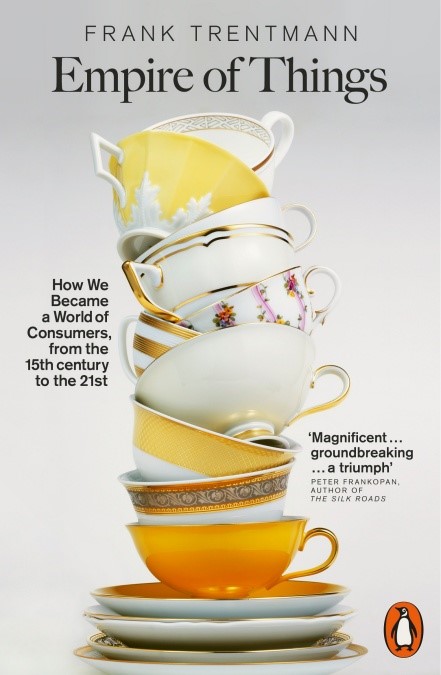Consumption is widely criticised in our developed societies: it would foster the culture of now and of immediate gratification at the expense of more lasting fulfilment; nurture inequalities and frustration; encourage debt; lead to lifestyles affected by overconsumption, and so on. And while we are aware of the major environmental impacts of our consumption, it can also be seen as an obstacle to the ecological transition, as was observed during the first weekend of the Citizens’ Climate Convention: “the deadlock today is that the culture of consumption still dominates our individual lifestyle”1 . So, do we need to move away from consumption, as some suggest? Or reinvent it? With Empire of Things,2 the historian Frank Trentmann provides a panorama of consumption, going right back in time and exploring different cultural contexts (Europe, Asia, United States). This work of reference helps us to understand the place of consumption in our societies, going well beyond its recent manifestations and the acceleration observed after the Second World War. This first blog post of a series of three chooses to take this book, comparing it with other resources, as an incentive to collectively redefine what we expect from consumption, and therefore consumption itself.
- 1https://www.conventioncitoyennepourleclimat.fr/wp-content/uploads/2019/10/Points-de-blocage-identifi%C3%A9s-par-les-membres-de-la-Convention.pdf
- 2Trentmann, F. (2016). Empire of Things. How We Became a World of Consumers, from the Fifteenth Century to the Twenty-First, Allen Lane.

F. Trentmann begins by remarking just how much we surround ourselves with “things”, how we have a highly developed material life and are defined more as consumers than as citizens. We are “customers”, even of public services, and the functioning of our economic systems depends on our spending,3 with the help of advertising, brands and credit. Finally, what we consume increasingly defines us socially, rather than our role in production, as was the case in the past. In this respect, consumption seems to be a key social phenomenon for understanding our societies. This blog post is organised around key lessons from F. Trentmann’s book, which challenge existing assumptions.
Consumption is a recent phenomenon. In fact, consumption is not a recent thing, as might be suggested by its intensification, driven by strong economic growth, after the Second World War. All of the components of a society of consumption were already present, at least since the beginning of the 20th century (diversity of supply, credit, consumer habits, Fordist model, etc.). The increase in consumption linked to the globalisation of trade even dates back to the 14th, 15th and 16th centuries, when economic growth was low.4 Over the centuries, according to F. Trentmann, the very notion of consuming has shifted from the idea of “consuming a candle”, in other words using up a resource, to a positive vision for individuals and society, in other words productive consumption; this change is partly down to economists who, since Adam Smith, have gradually strengthened the position of consumption in an approach based on value creation.
Consumption is a form of individualism. F. Trentmann shows that the concept of consumption is not unchanging and that various meanings have been applied to it, in particular giving greater importance to the collective dimension. In this respect, Venice and Florence, which were thriving cities in 16th century Italy, are an instructive example: consumption increased, but it was meant to last (a form of investment) and had a public role, for example the construction of chapels by wealthy families; its aim was to establish the posterity of the family and not just to enjoy strictly private goods. Between the 14th and 17th centuries, in Europe and China, another collective facet of consumption emerged: the diversification of clothing was a way to challenge the established order within these societies (dress code according to class), and was sometimes strictly regulated by the elites, as in Germany.
More recently, since the 1980s, citizens and consumers have been gradually opposed, and the emphasis has been on the importance of individual choice, including in public services. But when the figure of the consumer emerged in the early 20th century, F. Trentmann shows that this difference did not exist: causes and struggles could be common, especially in terms of social justice.5 In this context, the landmark speech6 by J.F. Kennedy in 1962 set out the four basic rights of consumers: the right to safety, the right to be informed, the right to choose, and the right to be heard. He noted that a heavy burden, including in terms of expertise, lay on consumers, who were under-informed and influenced by persuasive techniques. In the American President’s vision, “consumer rights would raise the standard of living for all”, and his perspective was thus one of collective progress, far removed from the vision of individual choice in the marketplace.
We consume in order to feel superior to others, to establish our position in society. According to F. Trentmann, the reality is far more complex. The question of social status and distinction/emulation mechanisms are certainly present, but other motives determine consumption: improving one’s standard of living and comfort; pursuing leisure activities, sports, family activities, etc. The incentive mechanism of consumption by the wealthiest people should not be the focus of attention, as we typically look around ourselves7 rather than above ourselves, especially since we live in middle class societies within which this consumption pattern is the norm.
Consumption poses a moral problem. F. Trentmann describes widespread pejorative attitudes towards consumer debt. He notes that debt posed no moral problem when it was incurred by the powerful, but when the poor had to implement credit strategies in order to survive in the 17th and 18th centuries, it then became shameful. However, with the Industrial Revolution, the credit sector developed and, at the turn of the 19th century, the boom in consumption and household equipment was driven by credit purchases, whether in France or in Germany. There was also a moral shift regarding credit in the United States where, having been considered a shameful practice, it was now seen as a serious practice, a form of saving that reflects household discipline.8 In these countries, the governments play a role in encouraging saving and regulating credit, or promoting debt. F. Trentmann cites the campaign to encourage saving in post-war Japan as one of the most far-reaching campaigns to change behaviours organised by a state in modern times. This example also shows that the inclination to save, or to consume, is not a cultural trait, but may be linked to state policies: thus, when the Japanese campaign ended, the rate of saving fell sharply. More broadly, F. Trentmann strongly challenges the moral arguments judging the consumption of frivolous objects driven by irresponsible credit that would lead a society to ruin.
These initial elements are a starting point for rethinking our relationship with consumption. In 1970, Jean Baudrillard10 observed that “just as medieval society was balanced on God and the Devil, so ours is balanced on consumption and its denunciation”. The second part of this series of three blog posts will continue this analysis, showing how to go beyond the call to “reject consumerism” and focusing on the role and legitimacy of the state in redefining the place of consumption.
- 3Black Friday and its huge media coverage are a perfect illustration of this.
- 4See the reference work by Angus Maddison, The World Economy, A Millennial Perspective, OECD, 2001.
- 5One example is tackling monopolies to reduce prices.
- 6In 1983, 15 March, the day of this speech, was marked as World Consumer Rights Day.
- 7See n°224 in Sciences Humaines, “La course à la distinction”, 2011.
- 8This is still the case in the United States, where it is sometimes necessary to have a credit history to prove good credit management.
- 10Baudrillard, J. (1970). La société de consommation, ses mythes, ses structures, Paris : Gallimard.


